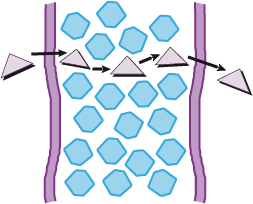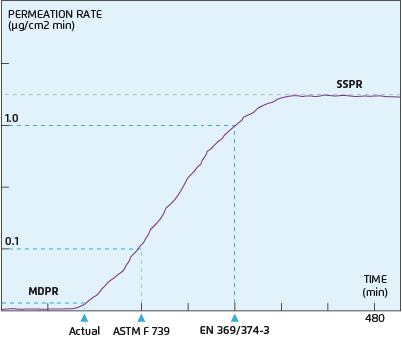Permeationswiderstand Gegen Chemikalien Nach EN 6529:2001
WAS IST PERMEATION?

Permeation ist ein Prozess, bei dem eine feste, flüssige oder gasförmige Chemikalie ein Material auf molekularer Ebene durchdringt. Die Permeation kann durch das folgende vereinfachte Diagramm dargestellt werden.
- Absorption von Molekülen an der (äußeren) Oberfläche des Materials.
- Diffusion der Moleküle durch das Material.
- Desorption der Moleküle an der gegenüberliegenden (inneren) Oberfläche des Materials.
PERMEATIONSMESSUNG
Die Barriereeigenschaften eines Materials oder einer Naht gegenüber der Permeation durch eine potenziell gefährliche Chemikalie werden durch Messung der Durchbruchzeit und der Permeationsrate durch das Material bestimmt. Permeationstests werden nach den Prüfmethoden ASTM F739, EN 369 oder EN 374-3 durchgeführt. Die Wahl der Methode ist abhängig von der Art des Gefahrstoffs sowie nationalen und örtlichen Vorschriften.
Die Außenfläche des Barrierematerials wird in einer Permeationsprüfzelle dem Gefahrstoff (flüssige oder gasförmige Chemikalie) ausgesetzt. Der Durchgang der Chemikalie wird durch Probenahme auf der Innenseite (Sammelseite der Zelle) und massenspektroskopischer Detektion überwacht.
Permeationsrate (PR)
Die Permeationsrate ist die Geschwindigkeit, mit der eine Chemikalie durch das Barrierematerial hindurchtritt. Die Permeationsrate wird ausgedrückt als die Masse der Chemikalien, die pro Zeiteinheit durch das Barriereaterial hindurchtritt, z. B. 2,0 µg/cm2/min bzw. 2 Millionstel eines g pro Quadratzentimeter pro Minute.
Permeationsrate im stationären Zustand (SSPR)
Die "Steady-State"-Permeationsrate, stellt sich nach dem Durchbruch ein, und zwar dann, wenn alle, die Permeattionsrate beeinflussenden Faktoren im Gleichgewicht stehen.
Minimal detektierbare Permeationsrate (MDPR)
Die minimal detektierbare Permeationsrate ist eine Funktion der Messempfindlichkeit der Analyseeinheit, des Messraumvolumes und der Messdauer. Die minimale nachweisbare Permeationsrate kann in bestimmten Fällen nur 0,001 μg/cm2 pro Minute betragen.
TATSÄCHLICHE DURCHBRUCHZEIT ODER "BREAKTHROUGH-DETECTION-TIME" (BDT)
Die durchschnittliche Zeit zwischen dem ersten Chemikalienkontakt mit der Materialaußenfläche und dem ersten Nachweis der Chemikalie an der Innenfläche.
Eine tatsächliche Durchbruchzeit von > 480 Minuten und eine Permeationsrate von „nd“ (not detected, nicht erkannt) bedeutet nicht, dass keinerlei Permeation erfolgt ist. Es bedeutet jedoch, dass die Permeationsrate auch nach einer Messzeit von acht Stunden unterhalb der minimalen Nachweisgrenze (MDPR) des Analysegerätes liegt.
Bei der Auswahl eines Barrierematerials gegen eine bestimmte Chemikalie werden MDPR und (erwartete) Expositionszeit verwendet, um zu bestimmen, ob - unter Berücksichtigung der Toxizität der Chemikalie - die Schutzleistung ist.
NORMALISIERTE DURCHBRUCHZEIT - NACH ASTM F739
Die durchschnittliche verstrichene Zeit zwischen dem ersten Kontakt der Chemikalie mit der Außenfläche des Materials und dem Zeitpunkt, zu dem die Chemikalie an der Innenfläche des Materials mit einer Permeationsrate von 0,1 μg/cm2/min nachgewiesen wird.
NORMALISIERTE DURCHBRUCHZEIT - NACH EN 374-3
Die durchschnittliche verstrichene Zeit zwischen dem ersten Kontakt der Chemikalie mit der Außenfläche des Materials und dem Zeitpunkt, zu dem die Chemikalie an der Innenfläche des Materials mit einer Permeationsrate von 1,0 μg/cm2/min erfasst wird. Somit ist die Durchbruchzeit „normalisiert“, da sie unabhängig von der Empfindlichkeit des Analysators ist. Hier wird der niedrigste Wert der Durchbruchzeit erfasst.
Eine normalisierte Durchbruchzeit von > 480 Minuten bedeutet, dass die durchschnittliche Permeationsrate nie die definierte Rate von 1,0 μg/cm² /min erreicht hat. Allerdings kann ein Durchbruch der Chemikalie tatsächlich stattgefunden haben, aber mit einer niedrigeren Rate.

LEISTUNGSKLASSIFIZIERUNG VON NORMALISIERTEN DURCHBRUCHZEITEN
Nach den europäischen Normen für Chemikalienschutzkleidung muss die Beständigkeit von Bekleidungsmaterialien gegen Permeation durch Chemikalien nach EN 369 oder EN 374-3 gemessen werden. Die normalisierten Durchbruchzeiten werden in sechs Leistungsklassen eingeteilt. Für die Europäische Norm ist die Korrelationstabelle zwischen der normalisierten Durchbruchzeit in Minuten und der Leistungsklasse in der folgenden Tabelle dargestellt
| Durchbruchzeit (EN 369) in Minuten | EN-Klasse |
|---|---|
| >= 10 | Klasse 1 |
| >= 30 | Klasse 2 |
| >= 60 | Klasse 3 |
| >= 120 | Klasse 4 |
| >= 240 | Klasse 5 |
| >= 480 | Klasse 6 |
WHAT IS PERMEATION?

Permeation is the process by which a hazardous liquid chemical moves through a protective clothing fabric, at a molecular level. Permeation can be represented by the following simplified diagram.
- Sorption of molecules of liquid onto the contacted (outside) surface of the fabric.
- Diffusion of the sorbed molecules across the fabric.
- Desorption of the molecules from the opposite (inside) surface of the fabric.
MEASURING PERMEATION
The barrier properties of a protective fabric or protective seam to permeation by a potentially hazardous chemical, is determined by measuring the breakthrough time and the permeation rate of the chemical through the test material. Permeation tests are conducted following the ASTM F739, EN 369 or EN 374-3 test methods depending on the country of use and their local regulations and the physical state of the hazardous material.
The outside surface of a test fabric is exposed to a liquid chemical or gas using a permeation test cell. Breakthrough of the chemical to the inside fabric surface is monitored by sampling the collection side of the cell and analytically determining when the chemical has permeated across the fabric by use Mass Spectrometer techniques.
Permeation rate (PR)
The rate at which the hazardous chemical permeates through the test fabric. Permeation rate is expressed as a mass of hazardous chemical flowing through a fabric area per unit of time e.g 2.0 µg/cm2 / min. or 2 millionths of a g per square centimetre per minute
Steady state permeation rate (SSPR)
The constant permeation rate that occurs after breakthrough when the chemical contact is continuous and all forces affecting permeation have reached equilibrium
Minimum detectable permeation rate (MDPR)
The minimum permeation rate that can be detected during a permeation test .MDPR is a function of the sensitivity of the analytical measurement technique, the volume into which the permeated chemical is collected and the sampling time. Minimum detectable permeation rates can be as low as 0.001 μg/cm2 per minute in certain cases.
ACTUAL BREAKTHROUGH TIME OR BREAKTHROUGH DETECTION TIME (BDT)
The average time elapsed between initial contact of the chemical with the outside surface of the fabric and the detection of the chemical at the inside surface by the analytical device.
An actual breakthrough time of >480 minutes and a permeation rate of “nd” (not detected) does not mean breakthrough has not occurred. It means that permeation was not detected after an observation time of eight hours.
Permeation may have occurred, but at a rate less than the minimum detectable permeation rate (MDPR) of the analytical device. MDPR can vary depending on the chemical or on the analytical device.
When selecting a chemical barrier fabric, the MDPR and expected exposure times are used to determine if the level of protection is sufficient taking into account the toxicity of the chemical used.
NORMALIZED BREAKTHROUGH TIME –ACCORDING TO ASTM F739
The average elapsed time between initial contact of the chemical with the outside surface of the fabric and the time at which the chemical is detected at the inside surface of the fabric at a permeation rate of 0.1 μg/cm2 / min.
NORMALIZED BREAKTHROUGH TIME – ACCORDING TO EN 374-3
The average elapsed time between initial contact of the chemical with the outside surface of the fabric and the time at which the chemical is detected at the inside surface of the fabric at a permeation rate of 1.0 μg/cm2 / min. Thus the breakthrough time is ‘normalized’ as it is independent of the analyser sensitivity. Here the lowest BT is recorded.
A normalized breakthrough time of >480 minutes means that the average permeation rate never reached the defined rate of 1.0 μg/cm2 /min. However the chemical may have actually broken through but at a lower rate.

PERFORMANCE CLASSIFICATION OF NORMALIZED BREAKTHROUGH TIMES
According to the European standards for Chemical Protective Clothing, the resistance of clothing materials to permeation by chemicals must be measured according to EN 369 or EN 374-3. The normalized breakthrough times are classified into six performance classes. For the European standard, the correlation table between the normalized breakthrough time in minutes and the performance class is shown in the followingtable
| Breakthrough time (EN 369) in minutes | EN Class |
|---|---|
| >= 10 | Class 1 |
| >= 30 | Class 2 |
| >= 60 | Class 3 |
| >= 120 | Class 4 |
| >= 240 | Class 5 |
| >= 480 | Class 6 |

